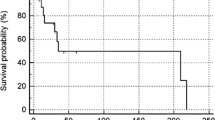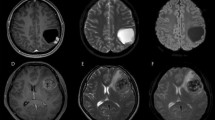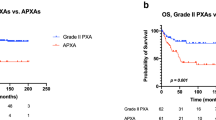Abstract
We present outcomes of pleomorphic xanthoastrocytoma (PXA) and correlate the impact of clinical, pathologic and molecular markers. Between 2006 and 2016, 37 patients with histologically verified PXA form the study cohort. All underwent maximal safe resection; those who had good resection and young age were observed. Adjuvant radiotherapy was given in patients with some atypical features such as high MIB-1 index (> 5%), residual disease or at recurrence. Patients with anaplastic PXA were administered adjuvant radiotherapy and systemic therapy. Median age at diagnosis was 20 years (range 4–45). At median follow-up of 33 months, 3-year and 5-year overall survival (OS) was 80.2 and 74% respectively. Patients who underwent GTR (23 cases, 62%) had significantly better 3-year PFS of 85.6% compared to 32.3% (p = 0.001) achieved with STR (13 cases, 35%). PFS was significantly superior in PXA grade II as compared to anaplastic PXA group (3-year estimates 80.2 vs. 32%; p = 0.007). 13 out of 27 patients where BRAFV600E testing was successful showed a mutation (48%). 3-year PFS and OS survival in BRAFV600E mutated patients was 51.9 and 76.9% compared to 73 and 75% in BRAFV600E non-mutated patients, respectively. No patient had IDH1 mutation. This data may provide valuable insights and act as a benchmark for future studies.



Similar content being viewed by others
References
Perkins SM, Mitra N, Fei W, Shinohara ET (2012) Patterns of care and outcome of patients with pleomorphic xanthoastrocytoma: a SEER analysis. J Neurooncol 110(1):99–104
Grier JT, Batchelor T (2006) Low-grade gliomas in adults. Oncologist 11(6):681–693
Forst DA, Nahed BV, Loeffler JS, Batchelor TT (2014) Low-grade gliomas. Oncologist 19(4):403–413
Vu TM, Luibinas SV, Gonzales M, Drummond KJ (2012) Malignant potential of pleomorphic xanthoastrocytoma. J Clin Neurosci 19(1):12–20
Ida CM (2015) Pleomorphic xanthoastrocytoma: natural history and long-term follow-up. Brain Pathol 25(5):575–586
Louis DN, Perry A et al (2016) World Health Organization classification of tumors of the central nervous system: a summary. Acta Neuropathol 131(6):803–820
Lassaletta A, Zapotocky M, Mistry M et al (2017) Therapeutic and prognostic implications of BRAF V600E in pediatric low-grade gliomas. J Clin Oncol 35(25):2934–2941
Venneti S, Huse JT (2015) The evolving molecular genetics of low-grade glioma. Adv Anat Pathol 22(2):94–101
Horbinski C (2013) To BRAF or not to BRAF: Is that even a question anymore? J Neuropathol Exp Neurol 72:2–7
Louis DN, Ohgaki H, Wiestler OD et al (2007) The 2007 WHO classification of tumors of the central nervous system. Acta Neuropathol 114(2):97–109
Schmidt Y et al (2013) Anaplastic PXA in adults: case series with clinicopathologic and molecular features. J Neurooncol 111(1):59–69
Yamada S, Kipp BR, Voss JS, Giannini C, Raghunathan A (2016) Combined “infiltrating astrocytoma/pleomorphic xanthoastrocytoma” Harboring IDH1 R132H and BRAF V600E mutations. Am J Surg Pathol 40(2):279–284
Hsiao SJ, Karajannis MA, Diolaiti D, Mansukhani MM, Bender JG, Kung AL, Garvin JH Jr (2017) A novel, potentially targetable TMEM106B-BRAF fusion in pleomorphic xanthoastrocytoma. Cold Spring Harb Mol Case Stud 3(2):a001396
Gallo P, Cecchi PC, Locatelli F et al (2013) Pleomorphic xanthoastrocytoma: long-term results of surgical treatment and analysis of prognostic factors. Br J Neurosurg 27(6):759–764
Bagriacik EU, Baykaner MK, Yaman M, Sivrikaya G, Durdag E, Emmez H et al (2012) Establishment of a primary pleomorphic xanthoastrocytoma cell line: in vitro responsiveness to some chemotherapeutics. Neurosurgery 70:188–197
Sugimoto K, Ideguchi M, Kimura T, Kajiwara K, Imoto H, Sadahiro H, Ishii A, Kawano H, Ikeda E, Suzuki M (2016) Epithelioid/rhabdoid glioblastoma: a highly aggressive subtype of glioblastoma. Brain Tumor Pathol 33(2):137–146
Kleinschmidt-DeMasters BK, Aisner DL, Birks DK, Foreman NK (2013) Epithelioid GBMs show a high percentage of BRAF V600E mutation. Am J Surg Pathol 37(5):685–698
Lee EQ, Ruland S, LeBoeuf NR, Wen PY, Santagata S (2016) Successful treatment of a progressive BRAF V600E-mutated anaplastic pleomorphic xanthoastrocytoma with vemurafenib monotherapy. J Clin Oncol 34(10):87–89
Brown NF, Carter T, Mulholland P (2016) Dabrafenib in BRAFV600-mutated anaplastic pleomorphic xanthoastrocytoma. CNS Oncol 6(1):5–9
Sullivan RJ, Flaherty KT (2013) Resistance to BRAF-targeted therapy in melanoma. Eur J Cancer 49:1297–1304
Chang L, Karin M (2001) Mammalian MAP kinase signalling cascades. Nature 410(6824):37–40
Long GV, Stroyakovskiy D, Gogas H et al (2015) Dabrafenib and trametinib versus dabrafenib and placebo for Val600 BRAF-mutant melanoma: a multicentre, double-blind, Phase 3 randomised controlled trial. Lancet 386(9992):444–451
Robert C, Karaszewska B, Schachter J et al (2015) Improved overall survival in melanoma with combined dabrafenib and trametinib. N Engl J Med 372(1):30–39
Acknowledgements
We thank all our neurosurgery colleagues and other members of neuro oncology group for their patient referrals and management. We thank the Brain Tumour Foundation of India for providing us the financial assistance for conducting the molecular marker research component of the study.
Author information
Authors and Affiliations
Corresponding author
Ethics declarations
Conflict of interest
The authors declare that they have no conflict of interest or any financial disclosure.
Rights and permissions
About this article
Cite this article
Tonse, R., Gupta, T., Epari, S. et al. Impact of WHO 2016 update of brain tumor classification, molecular markers and clinical outcomes in pleomorphic xanthoastrocytoma. J Neurooncol 136, 343–350 (2018). https://doi.org/10.1007/s11060-017-2658-7
Received:
Accepted:
Published:
Issue Date:
DOI: https://doi.org/10.1007/s11060-017-2658-7




